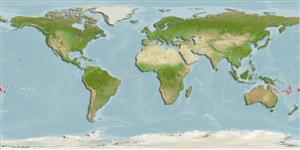Classification / Names
প্রচলিত নাম সমূহ | প্রতিনাম সমূহ | Catalog of Fishes(গণ , প্রজাতি ) | ITIS | CoL | WoRMS | Cloffa
>
Ovalentaria/misc (Various families in series Ovalentaria) >
Pomacentridae (Damselfishes) > Pomacentrinae
Etymology: Amphiprion: Greek, amphi = on both sides + Greek, prion, -onos = saw (Ref. 45335); barberi: Named for Dr. Paul Barber of Boston University, USA, for his contributions regarding genetic relationships of Indo-Pacific coral reef organisms.
Eponymy: Dr Paul Henry Barber is an American evolutionary biologist and ecologist. [...] (Ref. 128868), visit book page.
Environment: milieu / climate zone / গভীরতার পরিসীমা / distribution range
বাস্তুসংস্থান
সামুদ্রিক রীফ সংশ্লিষ্ট; গভীরতার পরিসীমা 2 - 10 m (Ref. 78105). Tropical
Central Pacific: Fiji, Tonga and American Samoa.
আকৃতি / ওজন / Age
পরিপক্কতা : Lm ? range ? - ? cm
Max length : 8.6 cm SL পুরুষ/ লিঙ্গ অনিধর্ারিত ; (Ref. 78105)
Short description
সনাক্তকারী নির্দেশক | বহিঃ অঙ্গ সংস্থান | মরফোমেট্রিক্স
পৃষ্ঠীয় কাঁটা (মোট ) : 10; পৃষ্ঠীয় নরম পাখনা দন্ড (মোট ) : 16 - 18; পায়ূ কাঁটা : 2; পায়ূর নরম পাখনা্তুন্ড: 14. This pomacentrid species is distinguished by the following characters: D X, 16-18 (usually X, 17); A II, 14; pectoral rays 18 (rarely 17); tubed lateral-line scales 36-43; gill rakers 5 + 12-14 (total 17-19); opercular spinules 11-19; body depth 1.7-1.9 in SL; body color generally red-orange including fins, grading to brownish on upper back of adults and a single white bar immediately posterior to the eye, its greatest width equal to that of eye or greater, narrowing to one-third to one-half of greatest width at dorsal midline (Ref. 78105).
The species is common on coral reefs, about 2-10 m and is generally commensal with large sea anemones, either Entacmaea quadricolor (Rüppell & Leuckart, 1828) or
Heteractis crispa (Ehrenberg, 1834). It is usually seen in groups that swim a short distance above their host anemones, apparently feeding on zooplankton. Reported to have been frequently encountered on local reefs in about 6-8 m depth, usually in association with Entacmaea quadricolor (Paul Brown, National Park of American Samoa, pers.comm.) (Ref. 78105). Oviparous, distinct pairing during breeding (Ref. 205). Eggs are demersal and adhere to the substrate (Ref. 205). Males guard and aerate the eggs (Ref. 205).
Life cycle and mating behavior
পরিপক্কতা | প্রজনন | ডিম ছাড়া | ডিমসমূহ | ডিম্বধারন ক্ষমতা | শুককীট
Oviparous, distinct pairing during breeding (Ref. 205). Eggs are demersal and adhere to the substrate (Ref. 205). Males guard and aerate the eggs (Ref. 205).
Allen, G.R., J. Drew and L. Kaufman, 2008. Amphiprion barberi, a new species of anemonefish (Pomacentridae) from Fiji, Tonga, and Samoa. aqua, Int. J. Ichthyol. 14(3):105-114. (Ref. 78105)
IUCN Red List Status (Ref. 130435: Version 2025-1)
Threat to humans
Harmless
Human uses
হাতিয়ার
Special reports
Download XML
ইন্টারনেট সুত্র
Estimates based on models
Preferred temperature (সূত্র
123201): 25.8 - 29, mean 27 °C (based on 256 cells).
Phylogenetic diversity index (সূত্র
82804): PD
50 = 0.5000 [Uniqueness, from 0.5 = low to 2.0 = high].
Bayesian length-weight: a=0.02344 (0.01134 - 0.04848), b=2.98 (2.80 - 3.16), in cm total length, based on LWR estimates for this (Sub)family-body shape (Ref.
93245).
ট্রফিক পর্যায়ে (সূত্র
69278): 2.7 ±0.3 se; based on size and trophs of closest relatives
স্থিতিস্থাপক (সূত্র
120179): উচ্চ, সর্বনিম্ন প্রজন দ্বিগুনের সময় ১৫ মাস (Preliminary K or Fecundity.).
Fishing Vulnerability (Ref.
59153): Low vulnerability (10 of 100).
🛈
